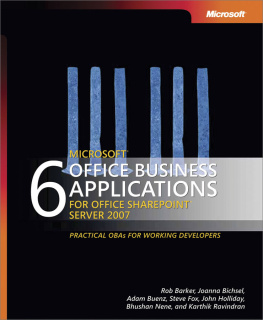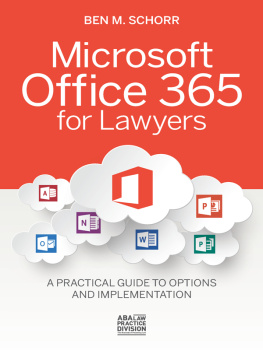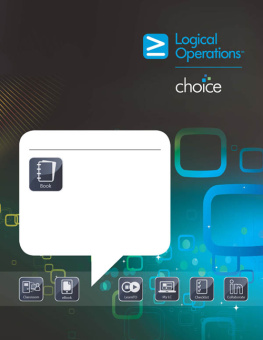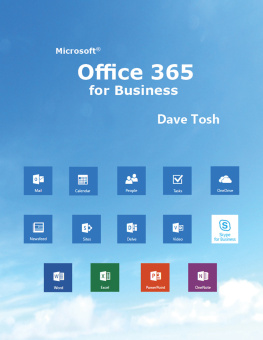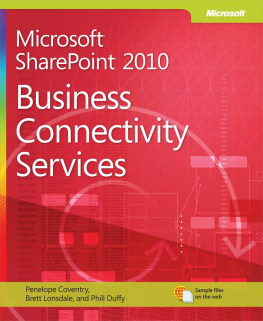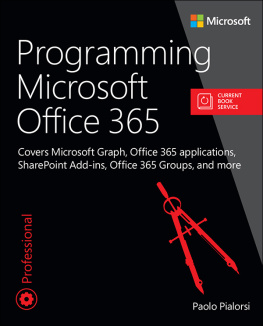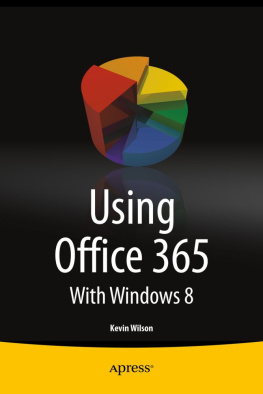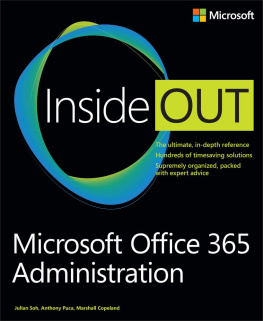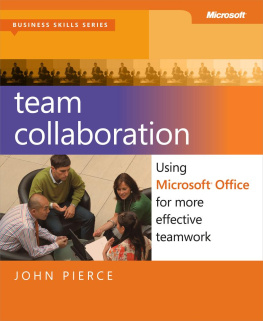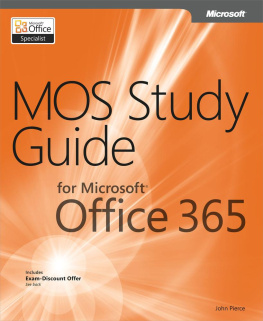Discover how to use the Microsoft Office system as a development platform with this practical guide. You\u2019ll learn the essentials for extending line-of-business applications to bring information to users\u2014and help improve enterprise productivity.
" name="description"/>
6 Microsoft Office Business Applications for Office SharePoint Server 2007
Microsoft Corporation
Published by Microsoft Press
Introduction
The work that Office Business Applications perform is at the heart of the requirements for information gathering and document processing that companies and organizations of all sizes face today in a business environment and economy characterized by mobility; a worldwide network of customers, partners, and suppliers; new compliance and regulatory requirements; and a need for broad visibility into business processes and the information that supports and governs them. Factors such as these drive the need for organizations to integrate business applications, documents, and workflows and transform the content of documents into business information they can act on.
6 Microsoft Office Business Applications for Office SharePoint Server 2007 offers examples of approaches that software developers and solution architects can take to extend the 2007 Microsoft Office system and provide business information to users. In this book, youll also find descriptions of Microsoft Office Business Application patterns that provide professional developers with guidance for developing their own custom 2007 Office system business solutions.
The 2007 Office system has numerous capabilities that address current business conditions, including the Open XML file formats, a highly programmable user interface, and an ability to more easily link to back-end and line-of-business data systems. The support of XML, for example, provides a means to define information workflows and document management capabilities. An organizations IT staff can integrate systems such as SAP, Siebel, or Microsoft Dynamics with 2007 Office system applications so that workers can perform operations such as invoicing or ordering when working in an Office application rather than in the back-end system itself.
6 Microsoft Office Business Applications for Office SharePoint Server 2007 focuses also on how to develop Office Business Applications on Microsoft Windows SharePoint Services and Microsoft Office SharePoint Server 2007, platforms that developers can use to create collaboration applications as well as applications and features that support business intelligence, workflow, data calculation, team workspaces, document life-cycle management, content management, knowledge discovery, and project management.
Information workers use an array of tools and devices to perform their jobs and collaborate with others: e-mail, desktop applications, mobile devices, Web browsers, Web conferencing, portals, and specialized line-of-business applications. Individual workers, project teams, and departments all need the capabilities provided by collaborative workspaces and the ability to archive and access information as projects are completed and new ones begin. Windows SharePoint Services, an integrated part of the Microsoft Windows Server operating system, provides services that enable teams and developers to build such workspaces. Windows SharePoint Services 3.0 can be tightly integrated with the 2007 Office system, further enabling information workers to make use of workspaces for organizing meetings, managing projects, authoring documents, and other activities that they frequently manage from traditional Office applications. Windows SharePoint Services 3.0 can also be integrated with line-of-business applications, providing access to data that workers need to update and analyze.
Office SharePoint Server 2007 builds on the Windows SharePoint Services framework and provides services such as search in portal sites, team sites, and content management sites; user profiles and audience targeting; and single sign-on to facilitate integration with enterprise data systems. Office SharePoint Server 2007 also introduces the Business Data Catalog, which enables integration between enterprise portal and line-of-business applications; new document management capabilities; Web content management, which provides tools for site branding, creating multilingual sites, and building content deployment solutions; Microsoft Office SharePoint Server 2007 Excel Services, a technology for viewing, calculating, and extracting values from a workbook through a Web browser or through a Web service; and Microsoft Office Forms Server 2007, which lets information workers use a Web browser to interact with form templates designed with Microsoft Office InfoPath 2007.
Six of the seven chapters in this book provide examples of the functionality and capabilities that can be included in a solution developed with Windows SharePoint Services, Office SharePoint Server 2007, and the 2007 Office system. These examples often show sample code, some of which was developed and tested on beta versions of Microsoft Visual Studio 2008. Youll see a Web Part that displays data from Active Directory, as well as examples of how to implement Excel Services to perform calculations and how to manage business processes with workflows. The examples are meant to show off features and concepts and to help generate ideas for solutions that can be developed or deployed in your own organization.
Who This Book Is For
6 Microsoft Office Business Applications for Office SharePoint Server 2007 will appeal to a variety of technically minded readers. Solution architects, for example, will find diagrams and discussions in the application chapters describing the components of the solution and their relationships. Developers will find a steady supply of sample code and development tips that demonstrate coding and implementation details. Technical decision makers will find summaries and related information about the business purpose and value of Office Business Applications and learn in more detail how Office Business Applications can be used to manage and automate business processes.
The examples provided are also applicable to organizations of various sizes. Small and medium-size businesses in markets and industries that rely on the extensive and regular use of documents and information technologyconsultants and law firms, for examplewill recognize advantages in examples such as the budgeting, sales forecasting, and statement of work solutions presented in , all of which are applicable to work at the enterprise scale.
About This Book
Each chapter in this book was written by a different individual, all of whom bring experience and expertise to the arena of Office Business Applications. Several of the authors work in the Office product group at Microsoft as technical program managers and developer evangelists. Several others are working software developers and consultants who are members of the Windows SharePoint Services MVP (Microsoft Most Valuable Professional) community.
Here is a quick summary of the contents of 6 Microsoft Office Business Applications for Office SharePoint Server 2007.
(Rob Barker, Microsoft Corporation) . An overview of OBA platform capabilities, OBA services, and the main architectural components of an OBA. This chapter also provides detailed descriptions and diagrams of a number of OBA application patterns that can be combined and adapted when developing custom applications.
(Steve Fox, Microsoft Corporation) . A combination of out-of-the-box workflows, Excel Services, Web Parts, and custom user interface elements that form an application used to approve and monitor budgets. This example demonstrates how to combine SharePoint technologies with Visual Studio Tools for Office customizations within the 2007 Office system environment. A workflow developed in Windows SharePoint Services ties the approval process together.

